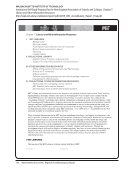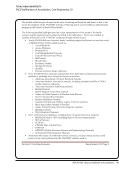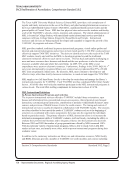130 · Representative Documents: Regional Accrediting Agency Reports
Massachusetts Institute of Technology
Institutional Self-Study Prepared for the New England Association of Schools and Colleges. Chapter 7:
Library and Other Information Resources
http://web.mit.edu/accreditation/report/pdfs/2009_MIT_Accreditation_Report_Final.pdf
Chapter 7: Library and Other Information Resources
Chapter 7 Page 84
efforts have focused on attracting expendable and endowed gifts to support targeted collection needs and
such common research-library needs as conservation, rare-book programming and stewardship, and the
digitization of valuable historical collections.
Service model
The Libraries’ service model is based on a strong, talented staff of some 35 subject-specialized librarians
who have responsibility for liaising with discipline-specific communities at MIT. This subject-based
approach to building and maintaining relationships with faculty and students not only provides deep
knowledge of activities and needs in the predominant departments, laboratories, and centers at MIT, but
also informs the ongoing development of new services and tools to anticipate the emerging requirements
of faculty, students, and researchers. Close collaboration with MIT’s central information-technology
organization is also an essential component of the Libraries’ service strategy, as many of the services
provided rely on the security and robustness of MIT’s network.
Integration of print and electronic resources has been supported through services designed to deliver print
materials such as articles and books directly to faculty desktops. During the last decade, the Libraries also
have invested in staff ,technology, and information content to meet new and emerging interdisciplinary
needs, including needs for social-science data services, geographic information systems, bioinformatics,
and copyright management.
Layered onto this service core are the goals of simplifying access to the Libraries’ materials, services, and
staff expertise, as well as instructing students in the skills needed to effectively find, evaluate, and use
information to support their learning and research at MIT and after graduation. One tactic for
accomplishing these goals is to develop self-teaching tools that provide community members, no matter
where they are, with unmediated, 24/7 access to resources and services, Another tactic is to partner with
faculty and other teaching staff to integrate lifelong learning skills into classroom and laboratory work.
Training to make effective use of resources
Following the recommendations of the faculty Task Force on Student Life and Learning in 1998, the
Libraries developed a program to become more engaged with the teaching activities of the Institute.
Formal instructional programs are now offered throughout the year, but most notably in January, April,
and July. A technology- and video-enabled classroom has been developed, and courses are increasingly
available around the clock on the Web.
In 2007 the Libraries received a grant from the d’Arbeloff Fund to integrate core scholarly research skills
into the curriculum of 3.091, a popular undergraduate chemistry General Institute Requirement (GIR).
Partnering with faculty members and the Teaching and Learning Laboratory, the Libraries have begun a
multiyear assessment to determine the impact of embedding these learning modules into the curriculum.
Results to date suggest that the scholarly research curriculum has improved students’ online search skills.
The Libraries are now approaching faculty who teach alternative chemistry GIRs to consider including
this same curriculum in those courses.
This past academic year, library instructional staff began an initiative to assess the effects of library
instruction related to other courses. The pilot included 154 undergraduate students involved in 14
different courses from a variety of disciplines. Preliminary results suggest that students benefited from the
library research training they received:
• Fifty-six percent agreed or strongly agreed that the training enabled them to identify appropriate
databases/tools to complete class projects.
• Sixty percent agreed or strongly agreed that because of the library training, they are more likely to
experiment with unfamiliar databases or tools for different subject areas.
• Fifty-three percent indicated they had used what they had learned in other classes.
• Twenty-six percent reported using what they had learned for purposes unrelated to coursework.
Massachusetts Institute of Technology
Institutional Self-Study Prepared for the New England Association of Schools and Colleges. Chapter 7:
Library and Other Information Resources
http://web.mit.edu/accreditation/report/pdfs/2009_MIT_Accreditation_Report_Final.pdf
Chapter 7: Library and Other Information Resources
Chapter 7 Page 84
efforts have focused on attracting expendable and endowed gifts to support targeted collection needs and
such common research-library needs as conservation, rare-book programming and stewardship, and the
digitization of valuable historical collections.
Service model
The Libraries’ service model is based on a strong, talented staff of some 35 subject-specialized librarians
who have responsibility for liaising with discipline-specific communities at MIT. This subject-based
approach to building and maintaining relationships with faculty and students not only provides deep
knowledge of activities and needs in the predominant departments, laboratories, and centers at MIT, but
also informs the ongoing development of new services and tools to anticipate the emerging requirements
of faculty, students, and researchers. Close collaboration with MIT’s central information-technology
organization is also an essential component of the Libraries’ service strategy, as many of the services
provided rely on the security and robustness of MIT’s network.
Integration of print and electronic resources has been supported through services designed to deliver print
materials such as articles and books directly to faculty desktops. During the last decade, the Libraries also
have invested in staff ,technology, and information content to meet new and emerging interdisciplinary
needs, including needs for social-science data services, geographic information systems, bioinformatics,
and copyright management.
Layered onto this service core are the goals of simplifying access to the Libraries’ materials, services, and
staff expertise, as well as instructing students in the skills needed to effectively find, evaluate, and use
information to support their learning and research at MIT and after graduation. One tactic for
accomplishing these goals is to develop self-teaching tools that provide community members, no matter
where they are, with unmediated, 24/7 access to resources and services, Another tactic is to partner with
faculty and other teaching staff to integrate lifelong learning skills into classroom and laboratory work.
Training to make effective use of resources
Following the recommendations of the faculty Task Force on Student Life and Learning in 1998, the
Libraries developed a program to become more engaged with the teaching activities of the Institute.
Formal instructional programs are now offered throughout the year, but most notably in January, April,
and July. A technology- and video-enabled classroom has been developed, and courses are increasingly
available around the clock on the Web.
In 2007 the Libraries received a grant from the d’Arbeloff Fund to integrate core scholarly research skills
into the curriculum of 3.091, a popular undergraduate chemistry General Institute Requirement (GIR).
Partnering with faculty members and the Teaching and Learning Laboratory, the Libraries have begun a
multiyear assessment to determine the impact of embedding these learning modules into the curriculum.
Results to date suggest that the scholarly research curriculum has improved students’ online search skills.
The Libraries are now approaching faculty who teach alternative chemistry GIRs to consider including
this same curriculum in those courses.
This past academic year, library instructional staff began an initiative to assess the effects of library
instruction related to other courses. The pilot included 154 undergraduate students involved in 14
different courses from a variety of disciplines. Preliminary results suggest that students benefited from the
library research training they received:
• Fifty-six percent agreed or strongly agreed that the training enabled them to identify appropriate
databases/tools to complete class projects.
• Sixty percent agreed or strongly agreed that because of the library training, they are more likely to
experiment with unfamiliar databases or tools for different subject areas.
• Fifty-three percent indicated they had used what they had learned in other classes.
• Twenty-six percent reported using what they had learned for purposes unrelated to coursework.
























































































































































































